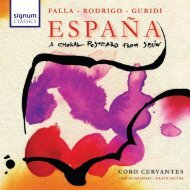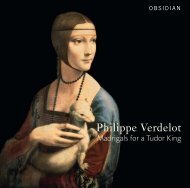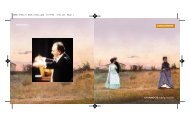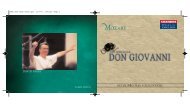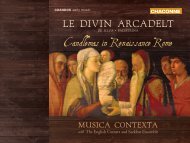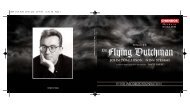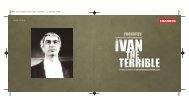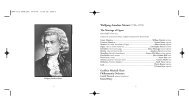Four Sacred Pieces | Hymn of the Nations - Chandos
Four Sacred Pieces | Hymn of the Nations - Chandos
Four Sacred Pieces | Hymn of the Nations - Chandos
You also want an ePaper? Increase the reach of your titles
YUMPU automatically turns print PDFs into web optimized ePapers that Google loves.
from <strong>the</strong> Festival dei due Mondi in Spoleto.<br />
Appearances at <strong>the</strong> Opera Giocosa in Savona<br />
(Don Giovanni and L’elisir d’amore), and as<br />
Almaviva (Il barbiere di Siviglia) with <strong>the</strong><br />
AsLiCo (Associazione Lirica Concertistica<br />
Italiana) quickly followed. He has since<br />
worked with stage directors such as Luc<br />
Bondy, Robert Carsen, Hugo De Ana, André<br />
Engel, Mario Martone, Pierluigi Pizzi, and<br />
Graham Vick under conductors including<br />
Bruno Campanella, Daniele Gatti, Daniel<br />
Harding, Lorin Maazel, Riccardo Muti,<br />
Gianandrea Noseda, and Daniel Oren.<br />
Francesco Meli has appeared in opera houses<br />
all over Italy, notably <strong>the</strong> Teatro alla Scala,<br />
Milan, Teatro Carlo Felice, Genoa, and at <strong>the</strong><br />
Rossini Festival in Pesaro, and abroad has been<br />
seen at The Royal Opera, Covent Garden, The<br />
Metropolitan Opera, New York, and in Lisbon,<br />
Valencia, Zurich, Lyon, Paris, and Vienna.<br />
His large repertoire includes roles in Idomeneo,<br />
Così fan tutte, Fidelio, La sonnambula, Anna<br />
Bolena, Maria Stuarda, Lucia di Lammermoor,<br />
Don Pasquale, Torvaldo e Dorliska, Bianca e<br />
Falliero, Maometto II, Rigoletto, La traviata,<br />
Simon Boccanegra, Otello, Falstaff, Wer<strong>the</strong>r,<br />
Manon Lescaut, and Dialogues des Carmélites.<br />
Since <strong>the</strong> end <strong>of</strong> <strong>the</strong> nineteenth century, <strong>the</strong><br />
Chorus <strong>of</strong> Teatro Regio, Turin has been<br />
one <strong>of</strong> <strong>the</strong> most important opera choruses in<br />
Europe. Re-established in 1945 after World<br />
War II, it became <strong>the</strong> permanent chorus<br />
<strong>of</strong> <strong>the</strong> <strong>the</strong>atre in 1967 and returned to <strong>the</strong><br />
highest level in 1973, when <strong>the</strong> new Teatro<br />
Regio was inaugurated, first with Francesco<br />
Prestia, <strong>the</strong>n with Adolfo Fanfani as Chorus<br />
Masters. The Chorus developed fur<strong>the</strong>r<br />
under Fulvio Fogliazza in <strong>the</strong> 1980s and<br />
1990s, confronting numerous contemporary<br />
pieces. Led by Bruno Casoni from 1994 to<br />
2002 and subsequently by Claudio Marino<br />
Moretti, <strong>the</strong> Chorus, made up <strong>of</strong> about<br />
seventy members, was directed from 2008 to<br />
2010 by Roberto Gabbiani, formerly Chorus<br />
Master at <strong>the</strong> Maggio Musicale Fiorentino<br />
(1974 – 89), Teatro alla Scala (1990 – 2002),<br />
and Accademia di Santa Cecilia (2002 – 06).<br />
He was succeeded by Claudio Fenoglio, who<br />
received his artistic training at <strong>the</strong> <strong>the</strong>atre.<br />
Regularly engaged in productions during<br />
<strong>the</strong> opera season, <strong>the</strong> Chorus also carries out<br />
assiduous concert activity, both symphonic<br />
and a cappella, in Torino and elsewhere. It has<br />
given particularly notable performances at<br />
<strong>the</strong> MiTo Settembre Musica 2008 and 2009,<br />
<strong>the</strong> Regio a Racconigi festival 2009, and with<br />
<strong>the</strong> Tonkünstler-Orchester Niederösterreich<br />
under Gianandrea Noseda at <strong>the</strong> 2009<br />
Musik-Sommer-Festival in Grafenegg. At <strong>the</strong><br />
11



